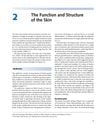TLDR Genes affect cytokine production, which can influence chronic diseases, and certain interventions may help prevent related molecular damage.
The document discussed the genetic control of cytokines, particularly focusing on interleukin 1 (IL 1) and its role in immune response and hair growth regulation. IL 1, produced mainly by keratinocytes in the skin, was found in significantly higher levels in the epidermis compared to other tissues. The study highlighted the importance of the dermal papilla in hair growth and the potential impact of IL 1 gene polymorphisms on alopecia areata. It concluded that alopecia areata is a multifactorial disease influenced by both genetic and environmental factors, with cytokine regulation playing a crucial role in the inflammatory response and clinical outcomes.
161 citations
,
March 1992 in “International Journal of Dermatology” Alopecia areata often starts before age 20, is more common in women, and may have a genetic link with other autoimmune diseases.
11 citations
,
December 1990 in “British Journal of Dermatology” Alopecia areata may involve disrupted mesenchymal function in hair follicles.
164 citations
,
November 1989 in “Clinical and Experimental Dermatology” Juvenile alopecia areata is more severe and has a worse prognosis than maturity-onset alopecia areata.
53 citations
,
April 1985 in “Developmental Biology” Fibronectin and other basement membrane components increase during hair growth and decrease during rest.
 4 citations
,
November 2014
4 citations
,
November 2014 The skin protects the body, regulates temperature, senses touch, and makes vitamin D.

Integrin alphavbeta6 is important for wound healing and hair growth, and blocking it may improve these processes.
 65 citations
,
February 2009 in “The journal of investigative dermatology/Journal of investigative dermatology”
65 citations
,
February 2009 in “The journal of investigative dermatology/Journal of investigative dermatology” Anti-acne medications may work by reducing the activity of a protein involved in acne development.
 22 citations
,
February 2013 in “Wound Repair and Regeneration”
22 citations
,
February 2013 in “Wound Repair and Regeneration” Mice genetically modified to produce more CD109 in their skin had less inflammation and better healing with less scarring.
 146 citations
,
January 2004 in “Hormones”
146 citations
,
January 2004 in “Hormones” Human skin acts like a hormone-producing organ, making and managing various hormones important for skin and hair health.
 5 citations
,
January 2019 in “Elsevier eBooks”
5 citations
,
January 2019 in “Elsevier eBooks” Current therapies cannot fully regenerate adult skin without scars; more research is needed for scar-free healing.






